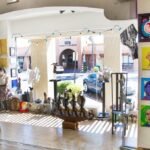Installation view of “Almost Unknown, The Afric-American Picture Gallery,” at Winterthur Museum, Garden & Library.
Winterthur Museum, Garden & Library.
An essay, sure.
A daydream, too.
A story. An imagined future.
An “intellectual funhouse” in the words of Jonathan Michael Square.
Square guest curated an exhibition at the Winterthur Museum, Garden & Library in Winterthur, DE inspired by the writing of 19th-century free Black journalist and educator William J. Wilson. Wilson’s article, “The Afric-American Picture Gallery,” was published in 1859 under the pen name “Ethiop” as a series of installments in the Anglo-African Magazine. It describes an imagined gallery space that Ethiop has curated. The author leads a tour of the artworks that both celebrate and critique the experience of free and enslaved Black Americans in the 19th century.
Square has attempted to bring Wilson’s fantasy gallery to life in the 21st century.
“Reading the essay, you can tell that he’s a creative person. I think he wanted to make a claim for the importance of African American life, African American creative expression,” Square told Forbes.com. “He wanted to mark this moment and think about what if there was an institution or a gallery or a museum, but he doesn’t use that word, that celebrates the challenges and triumphs of the African American experience.”
“This moment” Square refers to is the brink of Civil War.
“That word” Wilson doesn’t use is “museum.”
“In many ways, the idea of the museum was still in formation in the mid-19th century. A lot of the museums that we know and love today didn’t exist in 1859,” Square explains. “He uses the term picture gallery, and picture galleries had existed since antiquity. If you think about the word Pinacoteca, that comes from Latin and Greek. There have been Pinacoteca’s, or picture galleries, sometimes in aristocratic homes, sometimes open to the public. He was drawing more so from that lineage, less so from the museum, an Enlightenment era invention.”
By the mid-19th century, a greater amount of artwork created by African Americans to fill Wilson’s “picture gallery” existed than most people realize. Not all the pieces in Wilson’s Afric-American picture gallery were created by Black people. Most of them aren’t even actual, specific items. They are more types of things. Square assembled drawings, paintings, sculptures, and objects from across the massive Winterthur collections to fill Wilson’s imagined gallery.
“Winterthur is the go to place if you’re interested in early American decorative arts and material culture and so it’s the perfect place to have this exhibition because one of the running theses of the exhibition is how do you interpret old objects in new ways,” Square said. “Also, Wintertur’s collection is vast. There’s so much to choose from. There’s so many different stories that you can tell with Wintertur’s collection because they have so much to work with, primary sources.”
More than parroting Wilson’s imagined object list, Square provides a snapshot of Black life in the United States and across the Diaspora at the time.
William J. Wilson
Installation view of “Almost Unknown, The Afric-American Picture Gallery,” at Winterthur Museum, Garden & Library.
Winterthur Museum, Garden & Library.
Born free in or around 1818 in New Jersey, Wilson lived much of his adult life in Brooklyn and then Washington, D.C. He was a frequent contributor to Black periodicals in the 1840s and 50s. As a Brooklyn correspondent for Frederick Douglass’ “Paper,” he wrote about people, places, and the cultural scene.
Wilson spent time meandering around Broadway where Daguerreian photo studios had popped up everywhere by the late 1850s. These studios served as informal art galleries filled with portraits, landscapes, and other works. Frustrated by the absence of Black people and culture on display, Wilson wrote his “Afric-American Picture Gallery” essay imagining the first “museum” of Black art in the United States.
“Many people, when they think about 19th century African American history, they focus on a handful of figures like Frederick Douglass or Harriet Tubman, Sojourner Truth, etc., but there’s all these other figures that are understudied and are also really interesting,” Square said.
The same can be said about all periods of American history, whether focused on African Americans or not. Americans have a tradition of flattening their history to make the story simpler, easier. The Founding Fathers. Lincoln and Douglas. Grant and Lee. Sitting Bull, Crazy Horse, and Geronimo. Martin and Malcolm. The tip of the iceberg.
“I want (visitors) to understand that complexity of intellectual history amongst elite African Americans in 19th century, and William J. Wilson was very much of that orbit,” Square said. “He was born free, well educated, and rubbed shoulders with these Black intellectuals in the U.S. in the 19th century.”
Wilson took part in the Colored Conventions movement and was a key writer of the opening speech of the 1855 National Colored Convention in Philadelphia. The conventions were political gatherings by Black Americans that played a crucial role in advocating for civil and human rights, particularly before and during the Civil War, and into Reconstruction.
Afric-American Picture Gallery
Installation view of “Almost Unknown, The Afric-American Picture Gallery,” at Winterthur Museum, Garden & Library.
Winterthur Museum, Garden & Library.
“Almost Unknown, The Afric-American Picture Gallery,” on view through January 4, 2026, presents—for the first time ever—the gallery imagined by Wilson.
“The objects visitors will see may not be the exact ones that Wilson described. Instead, they reflect my reading of the text and its relevance today,” Square said.
“Almost Unknown” brings to light what Wilson’s essay described as an “almost unknown Gallery” by sharing objects from Winterthur’s collection, the premier collection of American decorative arts, 90,000 items strong dating back to the 1640s. About 60,000 were collected and bequeathed by founder Henry Francis du Pont. He transformed his family home into a showplace for his collection and opened Winterthur as a museum in 1951.
Square has been working on the exhibition since late 2019 attempting to process all that material. Objects on view include a silhouette attributed to Moses Williams, a modest trivet made in early America in the form of an African symbol, and copies of Harriet Beecher Stowe’s Uncle Tom’s Cabin and Phillis Wheatley’s Poems on Various Subjects.
A stereoscope allows visitors to view a room of leisure from Maryland’s Wye Plantation. Frederick Douglass was enslaved for a time there. He described the surroundings. At the center of the stereoscope image sits a giant billiards table. Astoundingly, that Wye Plantation billiard table is now part of the Winterthur collection. It is the earliest-known surviving billiards table made in the United States.
The actual table can be seen on a separate Winterthur house tour.
Exhibition text for “Almost Unknown” encourages guests to, “Gaze deeply into this stereoscope and conjure within your mind’s eye the clacking of billiard balls as enslaved people toiled within earshot…”
People like Frederick Douglass. Countless other brilliant thinkers who couldn’t escape. How they might have changed the world? Or simply led lives of peace and freedom and love unchained.
Wilson’s essay starts as a linear description of numbered objects in an imaginary gallery before taking a most unexpected and wild turn.
“Midway through the text, things become kind of kooky and fantastical, (Wilson) actually stops numbering the objects, and he goes into a Black Forest and finds these tablets and (he’s) thinking about American history,” Wilson explained.
The previously straightforward cataloguing of objects becomes a story, rich with characters and narrative. Something of a mini “Odyssey” or fable, or fairy tale.
“I think he was giving himself space to be creative and to imagine. He stopped following conventions and just started having fun,” Square said. “I tried to give myself that same license when curating the exhibition, to just have fun and imagine.”
Square worked closely with Winterthur’s design team evoking the fantastical and theatrical qualities of Wilson’s essay, drawing inspiration from 19th century magic lantern shows, shadow plays, and silhouette puppets. His exhibition mood board included visual references as wide-ranging as casinos, funhouse distortions, and the films of Jordan Peele.
His “intellectual funhouse.”
“We really wanted the exhibition to mirror the experience of reading the text. The text is very meandering and circuitous, and we wanted the exhibition to feel that way too,” Square explained. “I wanted to have a macabre texture because (the essay is) set in the mid-19th century. It’s very Edgar Allen Poe, sentimentalist novel; I wanted (the exhibition) to feel like that and I think (the design team) did a good job of translating the text into an actual immersive experience.”
Installation view of “Almost Unknown, The Afric-American Picture Gallery,” at Winterthur Museum, Garden & Library.
Winterthur Museum, Garden & Library.
Consideration for the exhibition’s look and feel came at the outset, and objects were selected to reflect them as much as the other way around.
A striped wallpaper made from digital reproductions of 19th-century African American newspapers, including “The Provincial Freeman,” published by Mary Ann Shadd Cary—the first African American woman to publish a newspaper—sets the tone. Cary, born in Delaware and later an educator there, embodies the type of self-determined figure the exhibition seeks to center.
As Wilson’s essay went further afield, its scope widened and commentary sharpened. The author presents a vicious takedown of George Washington. Slaveholder. The aspect of the so-called “Father of the Country” popular history ignores.
Slaveholder.
Never freed them.
George Washington.
Wilson’s essay had a small readership which is why his critique Washington didn’t cause an uproar.
Winterthur’s collection includes more than 600 depictions of George Washington, many of them prominently displayed in the main rooms of the house.
Wilson’s imagined Afric-American Picture Gallery was never realized. In the 150-plus years since, however, Square believes a few institutions have come close. Along with his exhibition at Winterthur, he calls out Harlem’s Schomburg Center for Research in Black Culture, the National Museum of African American History and Culture in Washington, D.C., the reinstalled American wing of the Brooklyn Museum, and the Afrofuturist period room at the Metropolitan Museum of Art as contemporary manifestations of Wilson’s idea.


No Comment! Be the first one.